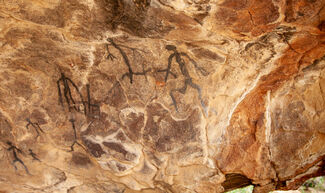Nature Watch: Pictographs
Last updated 3/22/2021 at 12:21pm
Reaching into the yawning mouth of the dusty clay pot, I could feel the fingerprints of the native Kumeyaay maker.
It was an overpowering connection to another wilderness traveler who stood in the same spot many centuries ago.
I had found the olla many years ago while hiking with an Anza-Borrego park ranger and after we carefully recorded the location, we carried it back to become part of the park's archeological collection. Today, people who discover such artifacts are encouraged to leave them in place.
Finding pottery left behind by early Native Americans is rare but visitors to Anza-Borrego's remote places are more likely to come upon ancient rock art known as pictographs.
There's a good reason that the locations of these sites are not publicized or marked on park maps.
In places easily accessible to the public, many of these delicate forms of Native American art have been loved to death.
Attempts to "refresh" the pictographs have actually defaced or even destroyed them.
Other forms of rock art, known as petroglyphs, are carved into boulders and are more durable.
The Anza-Borrego Foundation and the state park have launched a "Leave No Trace" program to teach visitors how to enjoy the desert without damaging the delicate landscape or historical artifacts.
Principle number four is "Leave what you find and do not touch or disturb cultural and historic artifacts."
"Touching rock art causes harm in numerous ways. If you touch rock art you could smear natural oils and dirt you gathered on your hands on to the rock art," said Hayley Elsken, Associate State Archaeologist in Anza-Borrego.
The images are often faded, and continued touching could destroy the delicate pigments made from desert plants and minerals.
"This is very similar to the reason you aren't allowed to touch paintings in museums. We want to protect rock art out of respect for the Kumeyaay people who created it and for the experiences of future visitors to the park," Elsken said. "We want to protect rock art out of respect for the Kumeyaay people who created it and for the experiences of future visitors to the park."
One of Anza-Borrego's biggest treasures is the preservation of open space and an environment that has not changed since the first human footprints appeared.
Included in that landscape are the fading cultural objects of the early people who lived here.
Help preserve them.
Contact Ernie @ Packtrain.com or follow http://ernieoutdoors.blogspot.com.




